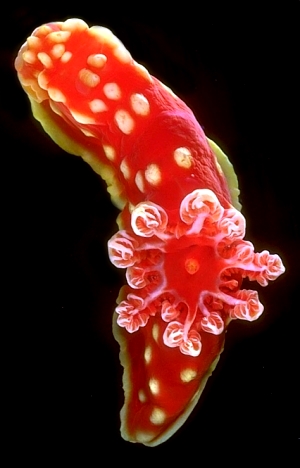
Gymnodoris aurita
(Gould, 1852)
Order: NUDIBRANCHIA
Suborder: DORIDINA
Superfamily: ANADORIDOIDEA
Family: Gymnodorididae
DISTRIBUTION
Wide tropical Indo-West Pacific distribution
PHOTO
North side of North Solitary Island, off Coffs Harbour, NSW, 29º55.75'S, 153º23.5'E, 9m, 22 February 1988, on brown branched soft coral, 1 specimen 71mm long, alive, AM C155648,
This large gymnodorid is characterised externally by its bright red colour, low rounded yellowish pustules, yellow rhinophores, yellow border to the foot, and large gills. Originally described from Fiji, I have specimens from Fiji, New Caledonia and Tanzania. Combined with Gosliner & Behren's records (1997) it suggests this species has a wide Indo-West Pacific distribution. It grows to at least 90 mm in length.
- Gosliner, T.M. & Behrens, D.W. (1997) Description of four new species of phanerobranch dorids (Mollusca: Nudibranchia) from the Indo-Pacific, with a redescription of Gymnodoris aurita (Gould, 1852). Proceedings of the California Academy of Sciences, 49(9): 287-308.
- Gould, A.A. (1852) United States Exploring Expedition during the Years 1838‑1842. Mollusca & Shells, 12: 1‑510. (with Atlas of Plates, 1856).
Rudman, W.B., 2006 (April 25) Gymnodoris aurita (Gould, 1852). [In] Sea Slug Forum. Australian Museum, Sydney. Available from http://www.seaslugforum.net/find/gymnauri
Related messages
Re: Gymnodoris aurita from Philippines
July 25, 2008
From: Marcel A. Tanke
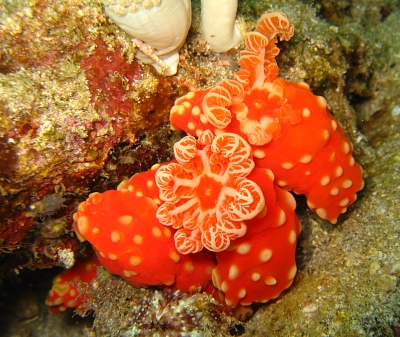
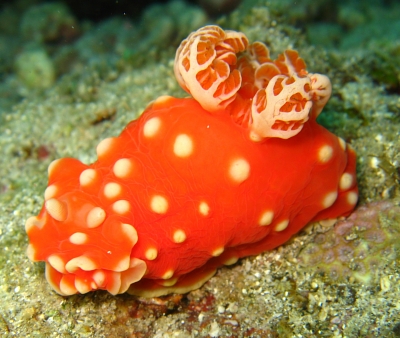
Concerning message #16156:
Dear Bill,
In Anilao we found several Gymnodoris aurita. In the first picture 3 specimens together (the third one is the one hardly visible on the left). The right one seems to have damaged gills.
Locality: Anilao, Kirby's Rock site, about 10 meters, Philippines, 12 July 2008, sandy / rocky area. Length: 10 cm. Photographer: Marcel Tanke.
The two lower photos are of the same animal.
Best regards,
Marcel
marceltanke@cs.com
Tanke, M.A., 2008 (Jul 25) Re: Gymnodoris aurita from Philippines. [Message in] Sea Slug Forum. Australian Museum, Sydney. Available from http://www.seaslugforum.net/find/21705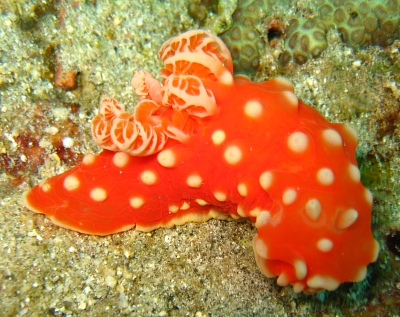
Dear Marcel,
I think you have 4 animals in the top photo. There are 3 animals nestled together - one in the middle with gills intact and fully extended, one above it in the photo with damaged gills, and one below it with gills and rhinophores fully retracted. There is also one in a crevice below them - you can see a bit of it on the left of the photo.
Best wishes,
Bill Rudman
Gymnodoris aurita from Sth Africa
May 10, 2006
From: Colin Ogden
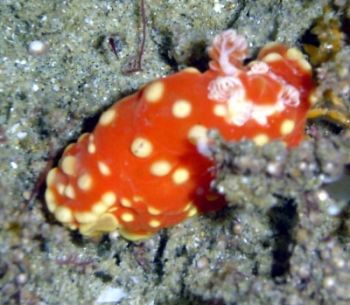
Hi Bill,
Sorry to hear about the disk crash, and thank goodness you have back ups. I'm gald to see you are back on stream. I know you devote a huge amount of your own personal time to the forum, and things like this must cause a huge back log for you. I know that I really appreciate all the assistance you have given to me on learning a little about this group of wonderful underwater creatures. I have tried to find this creature on the forum, but he doesn't appear. This is not a great picture, but I believe it is a Gymnodoris aurita.
Locality: Sodwana Bay, 22 metres, South Africa, Indian, 1 july 2005, Coral reef. Length: 40mm. Photographer: Colin Ogden.
Regards
Colin
scubaco@iafrica.com
Ogden C. M., 2006 (May 10) Gymnodoris aurita from Sth Africa. [Message in] Sea Slug Forum. Australian Museum, Sydney. Available from http://www.seaslugforum.net/find/16156Dear Colin,
Sorry but your message got caught up in the aftermath of the 'great disk crash' - forgotten but not lost - you might say. Things sometimes move fast on the Forum and while your message has been in limbo I have made a Fact Sheet for this species and posted a few interesting observations about it. This record of yours from South Africa complements a find I made in Tanzania in the 1970s and confirms that its distribution extends into the western Indian Ocean.
Best wishes,
Bill Rudman
Gymnodoris aurita from sthn Queensland
May 2, 2006
From: Bruce Wilkie
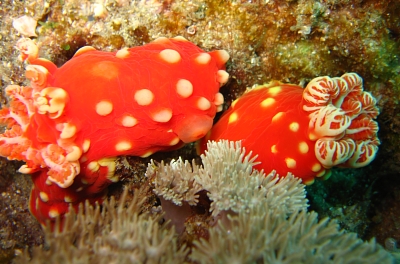
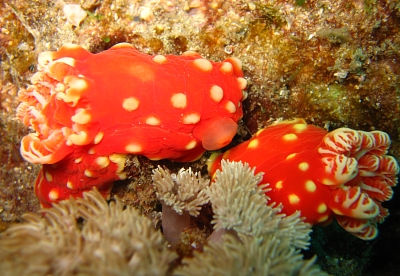
Hi Bill,
Have been reading Greg`s message #16449 concerning keeping Gymnodoris aurita in captivity and Dave`s message #16478 about what these animals have been recorded eating. By coincidence I found a pair of G. aurita the same day as Dave`s message was posted. I have included some photo`s for your records. Would it be a fair asumption, you would expect to find a species of Marionia in this area for these animals to feed on, or is it possible they may be feeding on something different? Looks like this is something else to put on my list of "things to look for"
Locality: Shag Rock, Point Lookout, North Stradbroke Island., 12 metres, Queensland Australia, Pacific ocean, 29 April 2006, rocky reef with sponges, hard & soft corals . Length: 80mm. Photographer: Bruce Wilkie.
Many Thanks,
Bruce Wilkie.
brucedwilkie@yahoo.com.au
Wilkie, B., 2006 (May 2) Gymnodoris aurita from sthn Queensland. [Message in] Sea Slug Forum. Australian Museum, Sydney. Available from http://www.seaslugforum.net/find/16487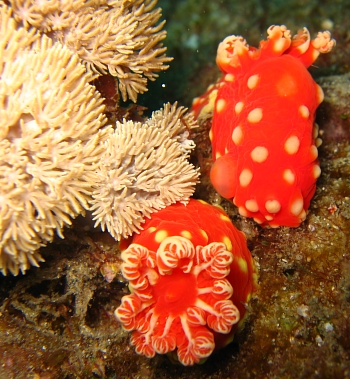
Dear Bruce,
Tritoniids - which G. aurita feeds on - eat soft corals, and are often found close to their food. So the large colony of a soft coral [perhaps Xenia] as in your photo suggests this is just the place a large tritoniid would be found. It is therefore not unexpected to find G. aurita lurking around. I think it would be a very good idea to add this Gymnodoris and large tritoniids, and their association with soft corals, to your 'to do' list.
The upper animal in your photos shows a swelling on the right side of the body, just behind the head, which is where the reproductive openings are, suggesting that the two animals are either about to or have recently mated.
Best wishes,
Bill Rudman
Marionia eating Gymnodoris aurita ?
May 1, 2006
From: Nonoy Tan
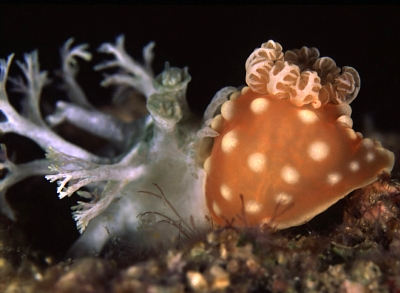
I found this Marionia trying to swallow a Gymnodoris. I learned from the "Nudibranch Behavior" that the Gymnodoris also eats the Marionia. So it seems that either can each the other!
Locality: Ligpo Island, 30 feet, Philippines, Balayan Bay. Photographer: Nonoy Tan.
Nonoy Tan
nonoytan@yahoo.com
Nonoy Tan, 2006 (May 1) Marionia eating Gymnodoris aurita ?. [Message in] Sea Slug Forum. Australian Museum, Sydney. Available from http://www.seaslugforum.net/find/16484Dear Nonoy,
I am not sure if your message is in reponse to Dave Behrens' message [#16478] or a remarkable coincidence. Your photo certainly shows that one species is biting the other but sometimes it is difficult to be sure who is biting who - particularly when the bite is mouth to mouth like this. If the one being eaten retracts its head when it is bitten, it can draw the head of the attacker into the retracted part of its body so that it looks as though the one being bitten is engulfing the attacker.
I am not sure that this is what your photo shows, but species of Gymnodoris are well-known eaters of other opisthobranchs, and Gymnodoris aurita is known to eat tritoniids such as Marionia. My first thought is that what we are seeing is the Gymnodoris, after biting the head of the tritoniid, being temporarily drawn into the body of the tritoniid which has retracted its head in reaction to the bite.
I would be interested in seeing any other photos you have of the incident to see if we can work out what is going on. Tritoniids usually feed on soft corals.
Best wishes,
Bill Rudman
Re: Bought at local fish store
April 29, 2006
From: Dave Behrens
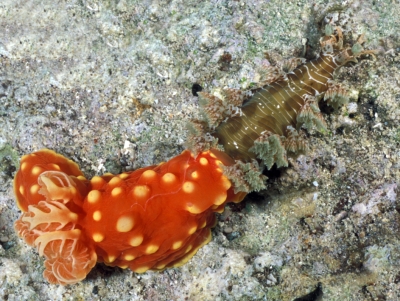
Concerning message #16449:
Hi Bill:
These aquarium stores are really doing their customers a dis-service. As reported in Nudibranch Behavior, Gymnodoris aurita has been documented feeding on Marionia. I highly doubt shops will carry this food source for their other species. Imagine paying $20 a meal to feed a $20 animal. And we thought gasoline in the US was high.
Locality: Lembeh Straits, Sulawesi Sea. Photographer: Constantinos Petrinos.
Dave Behrens
dwbehrens@comcast.net
Behrens, D.W., 2006 (Apr 29) Re: Bought at local fish store. [Message in] Sea Slug Forum. Australian Museum, Sydney. Available from http://www.seaslugforum.net/find/16478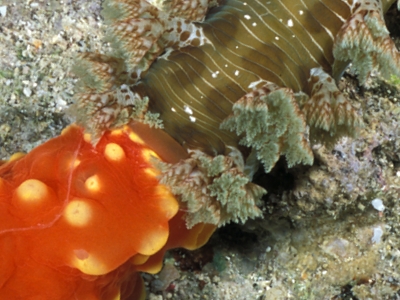
Thanks Dave,
I missed that feeding record,
Bill Rudman
Bought at local fish store
April 28, 2006
From: Greg Branson
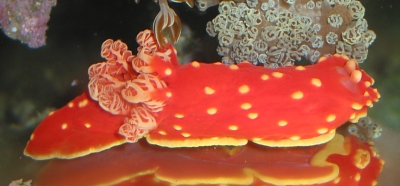
A local fish store sold us what they called a strawberry slug. We were hoping you could help us in determining the correct name and possibly what their diet consists of. The local fish store said they eat algae and sponges and if this is correct can they live on algae alone. We are willing to go out of our way to get the type of food if at all possible. Any information would be great.
Photographer: Jennifer Branson
Thank You
Greg Branson
pizzadude@alltel.net
Branson, G.P., 2006 (Apr 28) Bought at local fish store. [Message in] Sea Slug Forum. Australian Museum, Sydney. Available from http://www.seaslugforum.net/find/16449Dear Greg,
How can these shops get away with selling you things by giving you such spurious information! If this was a pet shop and they sold you a kitten and said that they were easy to keep - 'just feed them leaves and grass' it wouldn't be long before some animal rights group took them to court on the grounds of animal cruelty - if not customer deception.
Your animal is Gymnodoris aurita, and species of Gymnodoris don't eat algae and they don't eat sponges. They eat other sea slugs. We don't know what species G. aurita feeds on, but if you go to the Gymnodoris ceylonica Fact Sheet you will see reports of it feeding on the sea hare Stylocheilus striatus. That is not to say G. aurita will also eat sea hares but it will certainly eat some reasonably large sea slugs - but I can't say what species. When collecting species of Gymnodoris in the field it is necessary to keep them separated as they will often eat each other.
I am afraid I can't offer much assistance with your slug, but I would let your fish shop know that you are not happy with the standard of advice they are handing out.
Best wishes,
Bill Rudman
